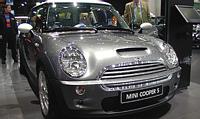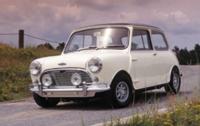A Maxi History Of The Original Mini

2003 Mini
|

2002 Mini
|

1950's Mini
|
CLICK2 British Mini Club
Mini History
By Carey Russ
British Motor Corporation (BMC) Project ADO-15 was a
revolutionary automobile, and, perhaps, the most historically
important after the Ford Model T. European journalists voted it
``Car of the Century'' (20th), for good reason. For maximum space
utilization, designer Alec Issigonis chose a front-engine, front-
wheel drive chassis layout, with the engine mounted sideways
between the front wheels, and the gearbox and final drive mounted
below and behind the engine.
Front-wheel drive was nothing new. Citroens, DKWs, and other
small cars of the first Mini's day used it, as did some highly-
successful Miller racing cars of the 1920s. But all previous front-
wheel drive production cars had used an inline engine, mounted
either in front of or behind the front axle and driving the wheels
through a conventional 90-degree differential. The transverse
engine layout had previously been used, by American
manufacturer Christie before 1910, but Christies were not mass-
produced, and some connected the engine's crankshaft directly to
the front wheels, something that would not make for easy driving.
Fast-forward to today, and it's hard to find a car that doesn't use
the Mini's basic layout. Nearly all small sedans, and most common
midsized ones, are transverse front engine, front-wheel drive
designs. The Toyota Camry, Honda Accord, and Ford Taurus all
are, as are all of Chrysler's sedans, and most of GM's. It's easier,
and shorter, to list cars that are not basically Mini-like in design.
The Mini's engine layout, and its use of 10-inch wheels, were
chosen to maximize interior space in a very small package. And at
10 feet in length, on an 80-inch wheelbase, it was short. With a
width of 55.5 inches and height of 53 inches, it was tiny, much
smaller than today's Mini, yet four adults could fit inside. Its 850cc
four-cylinder engine made all of 37 horsepower, which was
competitive for its class and day. Performance was helped by light
weight – curb weight was only 1340 lbs. Still, with a 0-60 time of
30 seconds and a top speed of 75 mph, it was not destined for
success in America, especially the America of the late 1950s and
early 1960s.
It was, however, a resounding success in England. If it wasn't
quick, it did handle, thanks to a rigid unit-construction chassis,
unusual for its day, and innovative fully-independent suspension.
Instead of normal steel springs and shock absorbers, the Mini used
rubber elastomer units much like those used in some of today's
bicycle suspensions. There is more than a little bicycle connection
there, actually, as they were developed by Alex Moulton, who
went on to develop bicycles that were as innovative as the Mini,
with small wheels and elastomer full suspension.
Meanwhile, there was another revolution going on in motor
racing. Thanks to pioneering designs by Englishman John Cooper,
engines of racing cars were being put behind the driver, resulting
in smaller, lighter, better-handling cars. And when Formula Junior
was introduced as a low-budget, entry-level class using
production-based engines, Cooper (and many other British race car
manufacturers) used BMC engines. And British racers had
discovered the joys of the Mini. Soon BMC contracted with
Cooper for high-performance versions of the Mini, and the Mini
Cooper was born.
The first Mini Cooper used a 997cc engine, with 55 horsepower.
Seven-inch disc brakes replaced the front drums, as 10-inch wheels
were still used. The little Minis were very successful in racing,
being able to make up in the corners what they lacked in straight-
line speed. Larger, more powerful cars were not immune from their
attacks, and it was usual to see a pack of Minis hounding (and
passing) Jaguars into the corners on British race tracks.
The 997cc Cooper led to the 1071cc Cooper S, with 68
horsepower. International racing and rallying successes were
becoming commonplace, and were furthered by the ultimate Mini,
the 1275cc Cooper S, with 76 horsepower in stock, street trim. The
1275's 0-60 time was an impressive-for-the day 10.9 seconds –
actually, not bad for a 1.3-liter car even today, and 1/3 the time of
the 850! With suitable competition modifications, somewhat more
than 76 horses could be coaxed reliably from the engine, and a
race-prepared Mini weighed even less than a street version. 1275
Cooper Ses were the terrors of the small-displacement sedan
classes worldwide in the mid- and late 1960s.
Sadly, the British automobile industry was in decline, and BMC
merged with Leyland, makers of Triumph cars among others, in
1968, forming British Leyland. The Mini Cooper didn't fit into the
British Leyland marketing scheme, and was phased out by 1971.
The regular Mini, on the other hand, soldiered on, with periodic
updates but in much its original form, until 2000, when it was
discontinued to make way for the current Mini Cooper. By then,
British Leyland had morphed into Rover Group, which was bought
in the mid-1990s by BMW. BMW really only wanted Land Rover,
and the Mini, so the rest of Rover was sold off to a British
company. And Land Rover was eventually sold to Ford. (note: this
is a capsule summary of some very complex business dealings, and
I'm probably leaving some important detail or other out, sorry.)
BMW owns Mini, and has set up a separate organization to build
Minis in England, and distribute them worldwide. That brings us
up to today. But there's more…
Mini Variations
Most Minis were the familiar (in England, anyway) two-box
Austin and Morris varieties. But there were also ``upscale'' models
sold under the Riley and Wolseley names, with vintage-looking
upright chromed grilles at front and a ten-inch extension for a
trunk (``luggage boot'' in British English) at the rear. They never
officially made it to the U.S. Then there were the Austin Mini
Countryman and Morris Traveller, extended-wheelbase, extended-
length (by 10 inches) wagon versions, with wood trim and
paneling. Mini Woodies! Most bizarre was the Mini Moke, a tiny
utility vehicle based on the Mini and featuring truly minimalist
styling.
Mini in Movies
I've often confused people by saying that something was ``more
fun than a barrel of Mini Coopers.'' Huh? Non-sequitur? Not at all.
Check your late-night TV listings or head to a well-stocked video
store for the 1969 British movie ``The Italian Job.'' If ``Bullitt''
has the most intense chase scene in moviedom, ``The Italian Job''
has the funniest. British humor can be funny!





